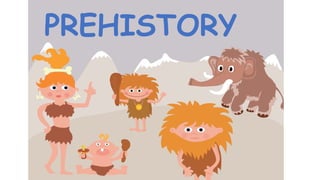
Prehistory
- 1. PREHISTORY
- 2. Historians divide Human History into two big periods: starts with the appearance of the first humans finishes with the invention of writing. 4.5 million years ago 5,500 years ago (= 3,500 years b.C.)
- 3. Historians also divide Prehistory into smaller stages, depending on the type of materials and technology used in those times: Stone Age Metal Ages Tools were made from STONE, wood and bones. Tools were made from METALS.
- 4. starts with the appearance of the first HUMANS finishes with the discovery of AGRICULTURE. 4.5 million years ago 5,500 years ago (= 3,500 years b.C.) PALAEOLITHIC
- 5. PALAEOLITHIC How did humans live in this period?
- 6. They were nomads. They didn’t have a fixed house. They moved around to find food. A nomad is a person who does not have a permanent home and moves around a lot.
- 7. They lived in caves. Sometimes they built huts with natural materials (wood, animal skins…). They lived in temporary shelters like tents, huts or caves because they were nomads. (refugios) (chozas)
- 8. They were organized in small groups (of 20/30 people called tribes).
- 9. They were hunters gatherers. They got their food hunting fishing and gathering fruits, nuts, berries, roots and other wild plants and
- 10. They made tools and weapons with: IVORY BONES WOOD STONE and(marfil)
- 11. Scrapers (raspadores) Arrowheads (puntas de flecha) They made: Antler harpoons from Altamira, used to catch fish. About 14,000 years old Harpoons (arpones)
- 12. Axes (hachas) Handaxe from Europe Needles (agujas) Bone needles from China, about 30,000 years old Wooden spear, Germany, about 400,000 years old. These spears are currently the oldest known wooden artifacts in the world. Spears (lanzas)
- 14. They learned to use fire. They used fire for heating and lighting caves, cooking and keeping wild animals away.
- 15. They drew and painted pictures of animals on cave walls and rocks. They painted mammoths, horses, deer, bisons, hunting scenes ... This type of art is called ‘cave art’. (arte rupestre)
- 16. Animal hairs were used to make brushes. They made paint crushing and mixing mineral pigments or charcoal with spit, blood or animal fat. (carbón) (saliva) (grasa)
- 17. How did people dress during the Paleolithic Age? • Clothing was made primarily from the fur of the animals that had been killed for food. • The climate during that time was cold, so people dressed to stay warm. Reconstruction of Neanderthal and Cro-Magnon. They made clothes from animal skins. (cosían) (marfil)
- 18. They sewed their clothes with needles made from bones, ivory and antlers.
- 19. NEOLITHIC How did humans live in this period?
- 20. They learned how to domesticate animals and cultivate plants. Domesticate means to train a wild animal to be useful to humans.
- 21. They tamed horses, dogs, goats, pigs, sheep, oxen …(amansaron) (bueyes)
- 22. They grew wheat, barley, peas, rice, corn … (trigo) (cebada) (guisantes) (maíz)(arroz) Wheat Barley
- 23. They became sedentary. A sedentary human is a person who lives in a fixed place because he has a permanent house. They settled down and built villages because they had to farm and needed to be close to their fields. They were not nomadic.
- 24. How did people dress during the Neolithic Age? • People still used mostly animal skins for clothing. • In some places people were able to make fabric from the wool of their sheep and from plants. Loom Raw wool
- 25. People used stone tools, but they began to be more sophisticated, specialized, and they were often polished to a fine finish. Farming tools were made with stone and wood.
- 26. They invented: The wheel The loomThe plough
- 27. They developed pottery for storing food and carrying things from place to place. (almacenar)(cerámica) They made pots with baked clay. (arcilla)(cocida)
- 28. They divided up the tasks in their community: Some raised animals Some made pottery Some made clothing Some built houses … Some cultivated crops
- 29. METAL AGES How did humans live in this period?
- 30. The main change was the discovery of metals. then they used bronze and later, they used iron. Metal tools are better than stone tools. They are stronger and can be sharpened. Gold and silver were used to make coins and jewellery. First they learnt how to melt copper and make tools with it,
- 31. Copper It was very soft and objects could deform quite easily. Bronze Mixture of copper and tin. – Harder and it can replace the stone for making weapons. Iron The hardest and most excellent for making weapons and farming tools. Bronze Age socketed axes
- 32. Metal workers had an important job: to make tools and weapons for everyone.
- 33. They made ovens to melt metals to make tools, weapons and jewellery.
- 34. • People had different Jobs now. 2 Metalworkers were people who made metalworking. Potters were people who made pottery, Jewellers were people who made jewels. Weavers were people who made clothes, fabrics… Other new jobs were … Soldiers were people who defended the town. Traders were people who bought and sold metal objects, clothes and pottery.
- 35. PALAEOLITHIC NEOLITHIC METAL AGES or ? Let´s analyze the following pictures
- 36. ???????
- 40. Add more …